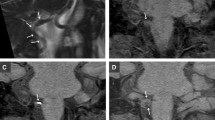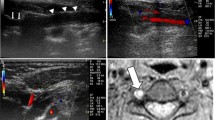Abstract
Objectives
To evaluate the feasibility of high-resolution MRI (HR-MRI) for diagnosing intracranial vertebrobasilar artery dissection (VBD) and to identify the most useful imaging findings suggesting dissection.
Methods
We retrospectively reviewed 50 patients with suspected intracranial VBDs who underwent HR-MRI. Two neuroradiologists independently reviewed the HR-MR images. The diagnosis based on HR-MRI was compared with the final diagnosis by consensus among the neuroradiologists, neurointerventionist, and neurologist. Two neuroradiologists also sought signs of dissection (mural hematoma, dissection flap, outer-diameter enlargement on T2WI of steno-occlusive lesions). Inter- and intraobserver agreements were analysed.
Results
HR-MRI corroborated the final diagnosis in 47 (94 %; 31 VBD and 16 non-VBD) patients. A mural haematoma was best detected on T1WI and contrast-enhanced (CE)-T1WI (54.3 %). Dissection flaps were observed in almost all cases on CE-T1WI (91.4 %), and then were detected on T2WI (68.6 %). Outer-diameter enlargement of the steno-occlusive lesions on angiography was detected in more than half of the cases (62.9 %). The two reviewers showed almost perfect agreement for the diagnosis of VBD and detecting dissection signs on every sequence.
Conclusions
HR-MRI can be a useful and non-invasive diagnostic tool for intracranial VBD, and dissection flaps on CE-T1WI are the signs with the greatest diagnostic value.
Key Points
• Direct imaging findings of dissection were well visualised by HR-MRI.
• Detection of a dissection flap on CE-T1WI is the most reliable diagnostic finding.
• HR-MRI could be a useful diagnostic tool for intracranial VBDs.



Similar content being viewed by others
Abbreviations
- VBD:
-
Vertebrobasilar artery dissection
- HR-MRI:
-
High-resolution MRI
- DSA:
-
Digital subtraction angiography
- CTA:
-
CT angiography
- MRA:
-
MR angiography
- PDWI:
-
Proton density weighted image
- VA:
-
Vertebral artery
- PICA:
-
Posterior inferior cerebellar artery
- SI:
-
Signal intensity
References
Schievink WI (2001) Spontaneous dissection of the carotid and vertebral arteries. N Engl J Med 344:898–906
Takano K, Yamashita S, Takemoto K, Inoue T, Kuwabara Y, Yoshimitsu K (2013) MRI of intracranial vertebral artery dissection: evaluation of intramural haematoma using a black blood, variable-flip-angle 3D turbo spin-echo sequence. Neuroradiology 55:845–851
Mohan IV (2013) Current optimal assessment and management of carotid and vertebral spontaneous and traumatic dissection. Angiology. doi:10.1177/0003319712475154
Provenzale JM, Sarikaya B (2009) Comparison of test performance characteristics of MRI, MR angiography, and CT angiography in the diagnosis of carotid and vertebral artery dissection: a review of the medical literature. AJR Am J Roentgenol 193:1167–1174
Engelter ST, Brandt T, Debette S et al (2007) Antiplatelets versus anticoagulation in cervical artery dissection. Stroke 38:2605–2611
Beletsky V, Nadareishvili Z, Lynch J et al (2003) Cervical arterial dissection: time for a therapeutic trial? Stroke 34:2856–2860
Biousse V, D'Anglejan-Chatillon J, Touboul PJ, Amarenco P, Bousser MG (1995) Time course of symptoms in extracranial carotid artery dissections. A series of 80 patients. Stroke 26:235–239
Kaufmann TJ, Huston J 3rd, Mandrekar JN, Schleck CD, Thielen KR, Kallmes DF (2007) Complications of diagnostic cerebral angiography: evaluation of 19,826 consecutive patients. Radiology 243:812–819
Lum C, Chakraborty S, Schlossmacher M et al (2009) Vertebral artery dissection with a normal-appearing lumen at multisection CT angiography: the importance of identifying wall hematoma. AJNR Am J Neuroradiol 30:787–792
Oppenheim C, Naggara O, Touze E et al (2009) High-resolution MR imaging of the cervical arterial wall: what the radiologist needs to know. Radiographics 29:1413–1431
Chung JW, Kim BJ, Choi BS et al (2013) High-resolution magnetic resonance imaging reveals hidden etiologies of symptomatic vertebral arterial lesions. J Stroke Cerebrovasc Dis. doi:10.1016/j.jstrokecerebrovasdis. 2013.02.021
Naggara O, Louillet F, Touze E et al (2010) Added value of high-resolution MR imaging in the diagnosis of vertebral artery dissection. AJNR Am J Neuroradiol 31:1707–1712
Rodallec MH, Marteau V, Gerber S, Desmottes L, Zins M (2008) Craniocervical arterial dissection: spectrum of imaging findings and differential diagnosis. Radiographics 28:1711–1728
Landis JR, Koch GG (1977) The measurement of observer agreement for categorical data. Biometrics 33:159–174
Leclerc X, Lucas C, Godefroy O et al (1999) Preliminary experience using contrast-enhanced MR angiography to assess vertebral artery structure for the follow-up of suspected dissection. AJNR Am J Neuroradiol 20:1482–1490
Kim BM, Kim SH, Kim DI et al (2011) Outcomes and prognostic factors of intracranial unruptured vertebrobasilar artery dissection. Neurology 76:1735–1741
Huang YC, Chen YF, Wang YH, Tu YK, Jeng JS, Liu HM (2009) Cervicocranial arterial dissection: experience of 73 patients in a single center. Surg Neurol 72:S20–S27, discussion S27
Redekop GJ (2008) Extracranial carotid and vertebral artery dissection: a review. Can J Neurol Sci 35:146–152
Provenzale JM, Sarikaya B, Hacein-Bey L, Wintermark M (2011) Causes of misinterpretation of cross-sectional imaging studies for dissection of the craniocervical arteries. AJR Am J Roentgenol 196:45–52
Flis CM, Jager HR, Sidhu PS (2007) Carotid and vertebral artery dissections: clinical aspects, imaging features and endovascular treatment. Eur Radiol 17:820–834
Sedat J, Chau Y, Mahagne MH, Bourg V, Lonjon M, Paquis P (2007) Dissection of the posteroinferior cerebellar artery: clinical characteristics and long-term follow-up in five cases. Cerebrovasc Dis 24:183–190
Acknowledgements
The scientific guarantor of this publication is Sun Yong Kim. The authors of this manuscript declare no relationships with any companies, whose products or services may be related to the subject matter of the article. The authors state that this work has not received any funding. No complex statistical methods were necessary for this paper. Institutional Review Board approval was obtained. Written informed consent was waived by the Institutional Review Board. Methodology: retrospective, observational, performed at one institution.
Author information
Authors and Affiliations
Corresponding author
Rights and permissions
About this article
Cite this article
Han, M., Rim, NJ., Lee, J.S. et al. Feasibility of high-resolution MR imaging for the diagnosis of intracranial vertebrobasilar artery dissection. Eur Radiol 24, 3017–3024 (2014). https://doi.org/10.1007/s00330-014-3296-5
Received:
Revised:
Accepted:
Published:
Issue Date:
DOI: https://doi.org/10.1007/s00330-014-3296-5




